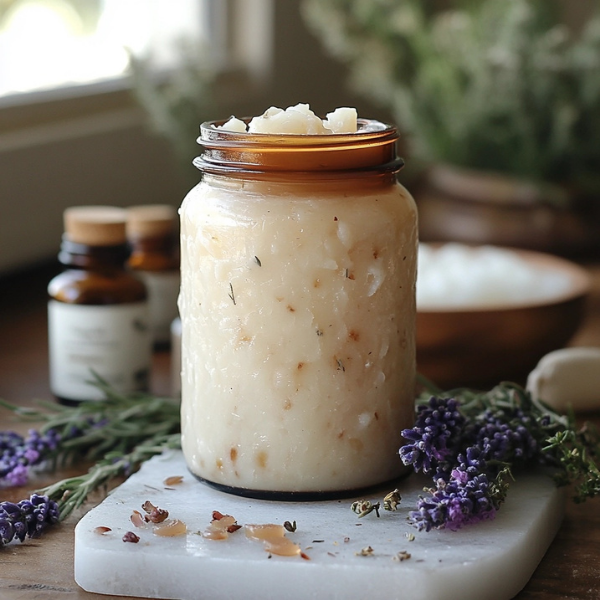Learn how to make tallow from beef fat at home with this easy guide. Perfect for cooking, skincare, and more. Save money and use natural ingredients for your needs.
Introduction:
Making tallow from beef fat is not only easy but also incredibly rewarding. Whether you’re interested in using it for cooking, skincare, or even crafting, rendering your own tallow ensures that you’re working with a pure, high-quality fat. Tallow is rich in healthy fats, offers natural hydration for the skin, and can even replace other oils in your cooking. In this guide, we’ll walk you through the simple steps to make your own tallow from beef fat.
Ingredients Overview:
- 2-3 pounds of beef fat (such as suet) – The main ingredient, this is the fat you’ll need to render into tallow.
- Optional: 1-2 tablespoons of water – Helps prevent the fat from burning as it melts.
- Optional: Herbs or spices – Add these to infuse a lovely scent into your tallow if you plan to use it for skincare.
Directions:
- Prepare the Beef Fat:
Begin by trimming off any remaining meat from the beef fat. Cut the fat into small chunks or cubes (about 1-2 inch pieces). This allows the fat to melt evenly and quickly. - Render the Fat:
Place the beef fat chunks into a heavy pot, Dutch oven, or slow cooker. Cook on low heat to allow the fat to gradually melt. Stir occasionally to ensure the fat doesn’t burn. As the fat heats, it will slowly turn into a liquid form. This process can take 3-4 hours depending on the method used. - Strain the Tallow:
Once the fat has fully melted into liquid, you’ll need to strain it. Place a fine-mesh sieve or cheesecloth over a clean jar or container and carefully pour the liquid tallow through. This removes any leftover impurities or solid bits of fat. - Store the Tallow:
Allow the liquid tallow to cool slightly before transferring it into an airtight container. As the tallow cools, it will begin to solidify. Store the finished tallow in the refrigerator to ensure freshness, where it will keep for several months.
How to Use It:
- For Cooking: Use tallow as a cooking fat in place of oils or butter. It’s great for frying, sautéing, and even baking. Tallow has a high smoke point, making it ideal for high-heat cooking.
- For Skincare: Apply a small amount of tallow to dry or cracked skin for moisturizing benefits. It’s particularly helpful for rough areas like elbows, feet, and hands.
- For DIY Projects: You can also use tallow in homemade soaps, balms, or candles.
Storage & Shelf Life:
- Storage tips: Store your homemade tallow in an airtight container in the refrigerator or a cool, dark place. This helps to maintain its freshness and prevent it from going rancid.
- Shelf life: Properly stored, your tallow should last for several months in the refrigerator. If you want to extend its shelf life even further, you can freeze it for up to a year.
Customization Tips:
- For a scent-infused tallow: If you’re using tallow for skincare, you can add herbs or essential oils like lavender, rosemary, or eucalyptus to give it a soothing fragrance.
- For a firmer tallow: Add more suet to increase the amount of fat rendered. This will give you a firmer texture when it solidifies.
- For cooking versatility: You can mix tallow with other fats (like coconut oil or butter) to create a blend that works best for your cooking needs.
Common Mistakes to Avoid:
- Overheating the fat: Render the fat on low heat to prevent burning and to maintain the quality of the tallow.
- Not straining properly: Make sure to strain the melted fat carefully to remove all impurities and ensure your tallow is smooth and pure.
- Storing in the wrong container: Use an airtight container for storage to avoid contamination and preserve the tallow’s freshness.
- Not checking for contamination: If you’re using tallow for skincare, ensure no solid bits of meat or skin remain in the tallow after straining.
FAQs:
1. How do I know when the fat is fully rendered?
When all the fat has melted into liquid and only small crispy bits (cracklings) remain, the fat is fully rendered.
2. Can I use tallow for deep frying?
Yes, tallow has a high smoke point and is excellent for frying, providing a rich flavor to your food.
3. Is there any special care needed when using tallow for skincare?
When using tallow for skincare, make sure to apply a small amount first to test for skin sensitivity. It’s great for dry, cracked skin but may be too heavy for oily or acne-prone skin.
4. How do I know if my tallow has gone bad?
If your tallow has an off smell, changes color, or develops mold, it’s best to discard it. Proper storage in an airtight container will help prevent spoilage.
5. Can I make tallow with other animal fats?
Yes, you can render tallow from any beef fat, but you can also render lard from pork fat or duck fat for similar uses.
Conclusion:
Making tallow from beef fat is an easy, cost-effective way to create a high-quality fat for cooking, skincare, and more. With just a few simple ingredients and some patience, you can render your own tallow at home, ensuring you have a natural, sustainable fat that’s as versatile as it is nourishing. Give it a try today and start enjoying the many benefits of homemade tallow!

